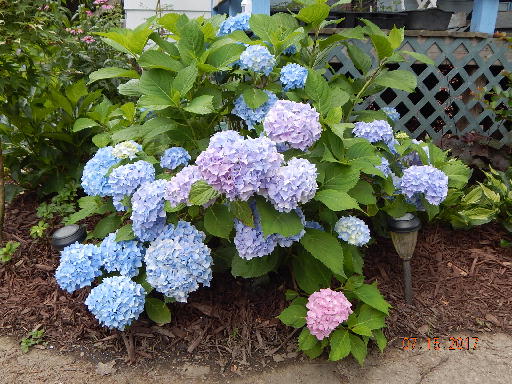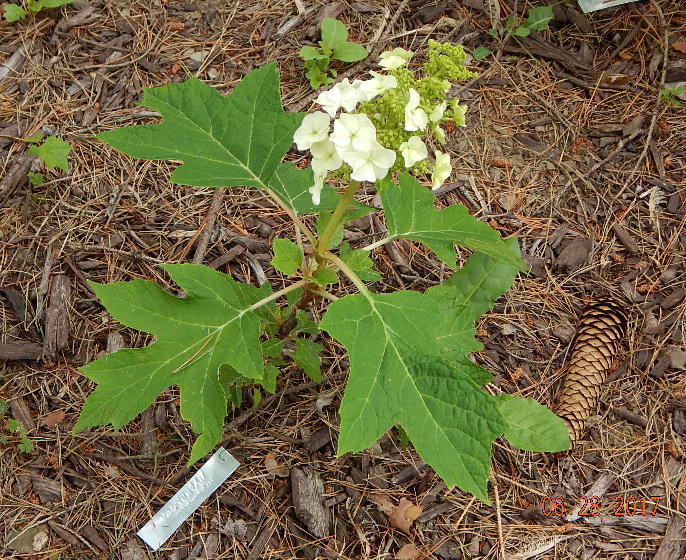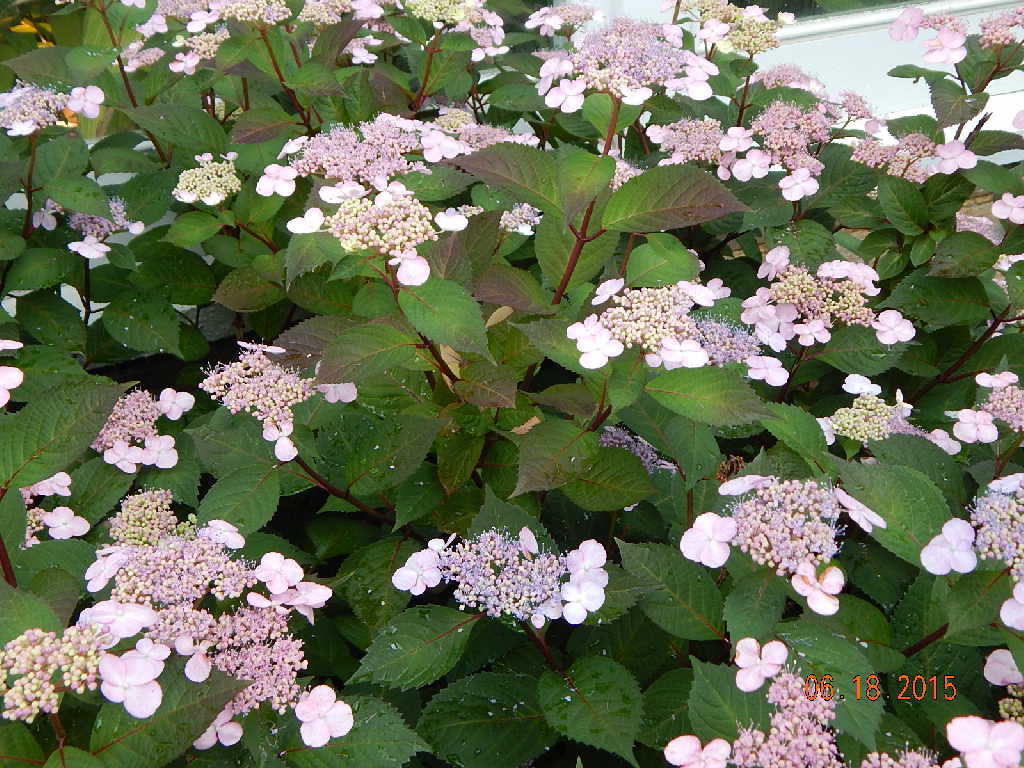Hydrangeas
Hydrangeas
Not all Hydrangeas are the same. There are different families of Hydrangeas available for the landscape. We grow several varieties of each here at our nursery.
A family would be what we think of as a group or type. There are big leaf ones that prefer a bit more shade. Then there are ones with smaller leaves that grow somewhat larger and can take full sun. The others kinda fall in between.
Hydrangeas are mostly known for their large clusters of flowers in either pink or blue. Usually, it depends on the amount of aluminum in the soil to determine the color. Alkaline soils are higher in aluminum and make pinker flowers. Acidic soils make bluer flowers.
Families of Hydrangeas
Macrophylla
Such a big word, but all it means is big leaf. We’ve all seen these. The large heart-shaped leaves on shrubs with round clusters of flowers.
Blue, shades of purple, or even pink. It all depends on the ph of the soil. Ph is a measurement of how acidic or alkaline the soil is. Ph actually stands for potential of hydrogen.
A better explanation of ph and why it matters can be found here. In the plant world, we usually want it somewhere near the middle or neutral. Hydrangeas with colored flowers will change colors depending on the ph in their soil. I have actually had different colors on the same shrub in the same year.
These Hydrangeas are probably the most common. They are also the basis for most complaints about a shrub that doesn’t flower. Their flower buds are set in the fall for the next year. That’s fine unless you have a very cold winter in between.
Hardy or not??
Most macrophylla Hydrangeas are rated for Zone 5 or 6 in cold hardiness. That means the plants will survive those cold temperatures for those zones. But, if the winter has some colder than average temperatures, the flower buds probably won’t survive. Check out the USDA Plant Hardiness chart for your zone.
In our neck of the woods, Zone 6a, we often lose the flowers. But this year was very good for flowering in our area. Lots and lots of flowers were seen in many yards. The flowers are worth missing a year or two.
Paniculatas
These are known as panicle Hydrangeas. Most of this family has white flowers and can take full sun. The flowers are often in a conical shape. The density, size, and arrangement of these vary depending on the variety.
The stems that hold these large flower panicles can be several feet tall. These stems grow throughout the season and bloom in mid to late summer. This makes them very dependable bloomers since they bloom on new growth.
Many of the varieties in this family can also be grown as a single trunked tree form. This allows most of the same great flowering but also has an open area underneath for underplanting of other plants like annuals if you desire. They also won’t be as large as their normal bush size.
Although the flowers bloom in white, their color changes as they age. Some have a different color prior to blooming. Most change as the flower ages. Shades of pink to varying degrees of tan or brown depending on the variety.
Arborescens
This is one of our native Hydrangeas. It comes from right here in the United States. It blooms with large round white flower clusters. It will grow a bit larger flowers if it gets more sun. They are dependable bloomers since they bloom on the new growth.
Serrata
This is known as the mountain Hydrangea. They grow in the mountains of Asia where the temperatures are colder. This makes it a bit more cold hardy than macrophyllas.
The flowers are really different as well. They grow in a flat cluster. The cluster has a ring of larger flowers with lots of tiny, tiny flowers in the center.
The bigger ones are only calling cards to get the attention of the pollinators. They are sterile and only there for show. It’s the tiny ones in the center that the pollinators want.
These flowers also depend on the soil ph for color. The more acidic the soil, the bluer the flowers. They will be pink if the acidity is lacking.
Quercifolia
Another weird name. These Hydrangeas actually have leaves that resemble oak leaves. They do well in shadier areas like edges of a woodline. This is another native family of Hydrangea, coming from the southeastern United States.
The flowers are also a bit different. Usually a large conicle shape similar to paniculatas but also a combination of sterile and fertile flowers. The flowers will also take on different shades as they grow.
Climbing
That’s right, this Hydrangea will actually climb up trellises or trees. It is more like a vine than a shrub or bush. They also take longer to mature enough for flowering. The leaves are much smaller as well.
Climbing Hydrangeas can be long-lived. They are often seen climbing up older, larger trees. Some universities have them growing their older trees on campus.
The flowers are white and really show off against a trellis or tree. I have one growing on my front porch railing. It has been growing for several years now and this was its first year with flowers.
Some of the Hydrangeas we may have available here.
Pee Gee

Pee Gee
Hydrangea paniculata ‘Grandiflora’
6 to 8 feet high and 8 to 10 feet wide
Full sun/partial shade
White flowers bloom in summer turning toward tan in fall. It can also be grown in tree form.
Phantom

Phantom
Hydrangea paniculata ‘Phantom’
6 to 8 feet high and 6 to 8 feet wide
Full sun/partial shade
Very large flower heads of white bloom at the ends of the current year’s growth in summer. Fade to pinkish-tan as they age. Stems are very thick, supporting the large flowers. It can also be grown in tree form.
Unique

Unique
Hydrangea paniculata ‘Unique’
6 to 10 feet high and 6 to 10 feet wide
Full sun/partial shade
Large flower heads of white bloom at the ends of the current year’s growth in summer. The petals are very open and airy. Large sterile petals mix in with many tiny fertile ones.
Silver Dollar

Silver Dollar
Hydrangea paniculata ‘Silver Dollar’
4 to 5 feet high and 4 to 5 feet wide
Full sun/partial shade
Smaller sized member of this family. Cluster of white petals form a head in late summer.
Nikko Blue

Nikko Blue
Hydrangea macrophylla ‘Nikko Blue’
4 to 6 feet high and 4 to 6 feet wide
Part shade
Round blue mophead flowers in acidic soil, pink to purple in alkaline soil.
Annabelle (Native)

Annabelle
Hydrangea arborescens ‘Annabelle’
3 to 5 feet high and 3 to 4 feet wide
Partial shade
Very large rounded flowerheads of a white bloom on ends of the new stems. Do best with some kind of support to hold up the large number of flowers.
Teller Blue

Teller Blue
Hydrangea macrophylla ‘Blaumiese’
3 to 4 feet high and 3 to 4 feet wide
Partial shade
Flowers consist of larger flat sterile petals surrounding the small fertile inner florets. Flowers are blue in acidic soil and pink to purple in alkaline soil.
Pink Diamond

Pink Diamond
Hydrangea paniculata ‘Interhydia’
8 to 10 feet high and 8 to 10 feet wide
Full sun/partial shade
Large flower heads of white bloom at the ends of the current year’s growth in summer. Fade to pinkish as they age. Stems are very thick, supporting the large flowers. It can also be grown in tree form.
All Summer Beauty

All Summer Beauty
Hydrangea macrophylla ‘All Summer Beauty’
3 to 4 feet high and 3 to 4 feet wide
Partial shade
Large rounded flower clusters throughout summer. Flowers are blue in acidic soil and pink to purple in alkaline soil.
David Ramsey

David Ramsey
Hydrangea macrophylla ‘David Ramsey’
4 to 5 feet high and 5 to 6 feet wide
Partial shade
Large rounded flower clusters bloom on old wood and new wood. More dependable bloomer than most. Flowers are blue in acidic soil and pink to purple in alkaline soil.
Tardiva

Tardiva
Hydrangea paniculata ‘Tardiva’
8 to 12 feet high and 7 to 10 feet wide
Full sun/partial shade
Flower heads of white bloom at the ends of the current year’s growth in summer. One of the latest bloomers. Stems are very thick, supporting the large flowers. It can also be grown in tree form.
Bluebird

Bluebird
Hydrangea serrata ‘Bluebird’
4 to 6 feet high and 4 to 6 feet wide
Part sun/partial shade
Flat flower heads with ring of larger sterile flowers surrounding tiny fertile blooms. Color is affected by ph of soil. Bluer flowers in acidic soil.
Ruby Slippers (Native)

Ruby Slippers
Hydrangea quercifolia ‘Ruby Slippers’
3 to 4 feet high and 3 to 5 feet wide
Part sun/partial shade
Conical flower heads of white bloom in early summer. Fade to pinkish-red as they age. Large oak-like leaves.
Munchkin (Native)

Munchkin
Hydrangea quercifolia ‘Munchkin’
3 to 4 feet high and 3 to 4 feet wide
Part sun/partial shade
Conical flower heads of white bloom in early summer. Smaller sized variety. Large oak-like leaves.
Climbing

Climbing
Hydrangea anomala petiolaria
30 to 50 feet high and 5 to 6 feet wide
Shade/partial shade
Open flower heads of white bloom in late summer. Small leaves on vine-like stems that will climb up trees and trellises.
Limelight

Limelight
Hydrangea paniculata ‘Limelight’
6 to 8 feet high and 6 to 8 feet wide
Full sun/partial shade
Conical flower heads of white bloom in early summer. Blooms start out with greenish tint. Strong stems allow for tree forms.
Chantilly Lace

Chantilly Lace
Hydrangea paniculata ‘Chantilly Lace’
5 to 6 feet high and 5 to 6 feet wide
Full sun/partial shade
Lacey conical flower heads of white bloom in mid summer. Stronger stems allow for short tree forms.
